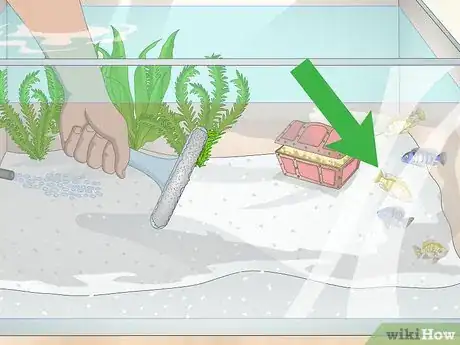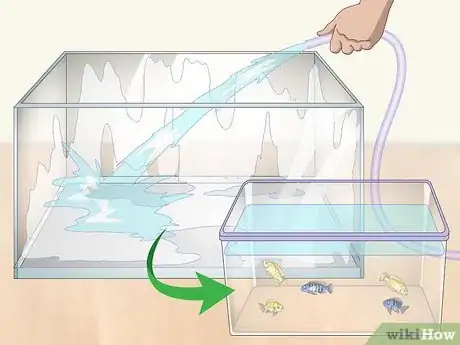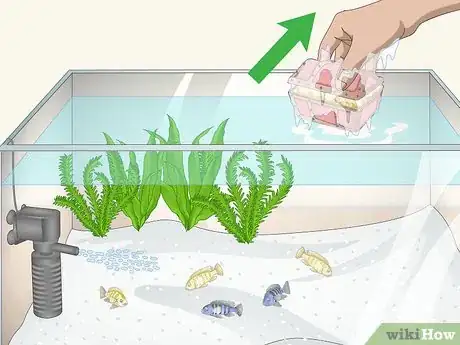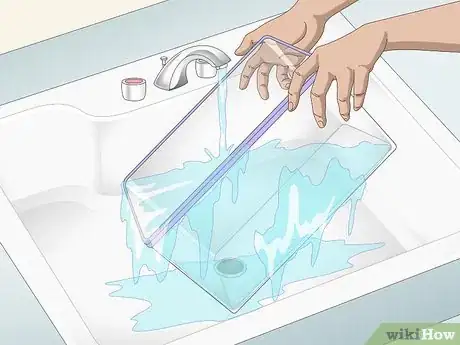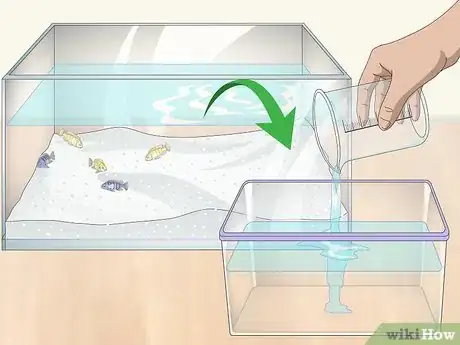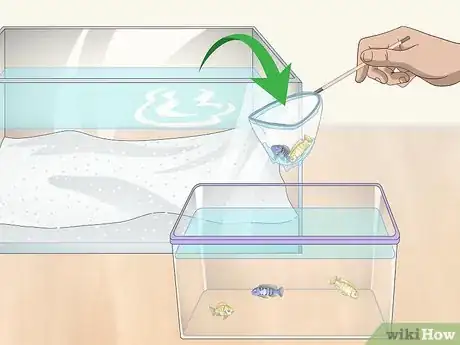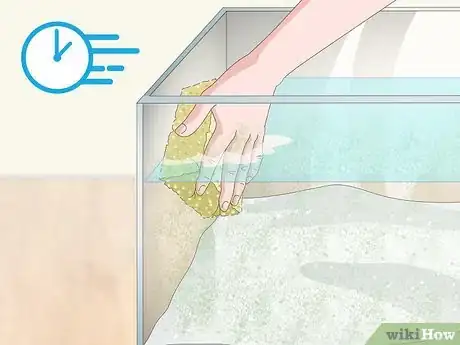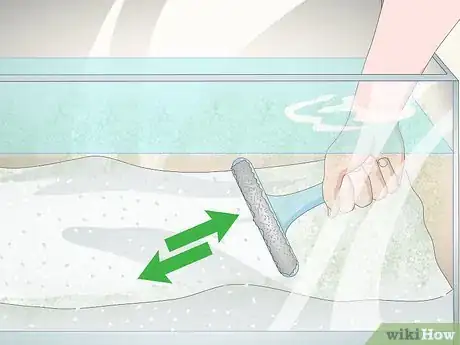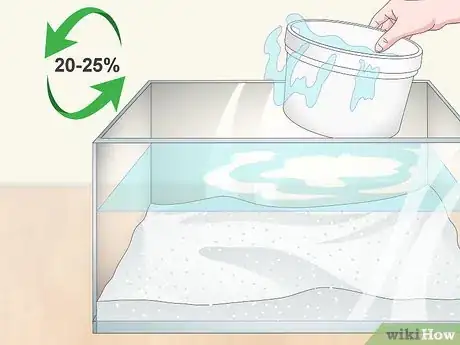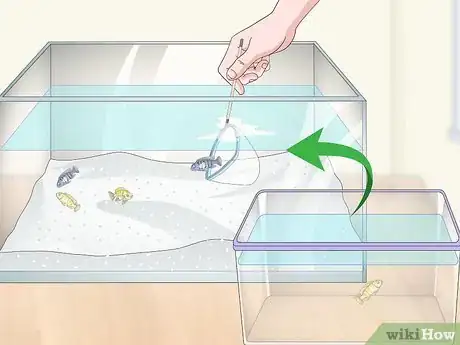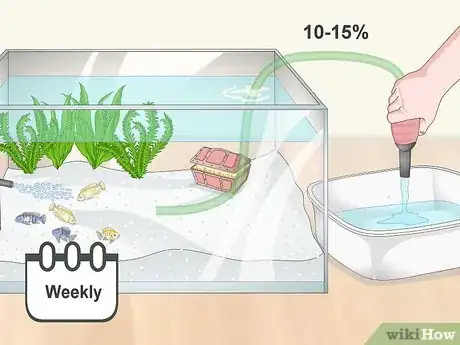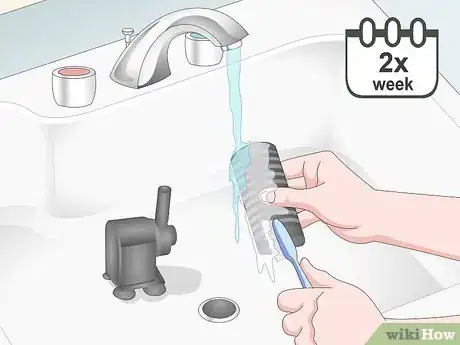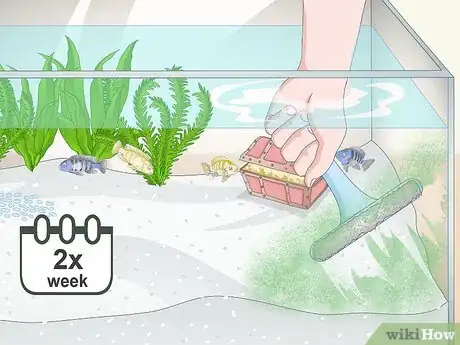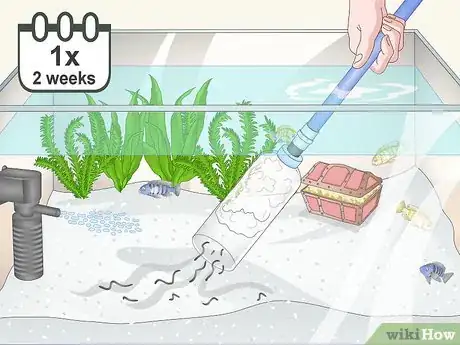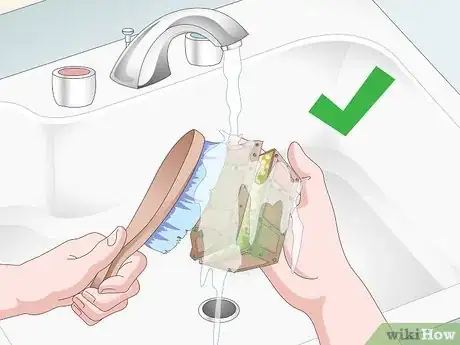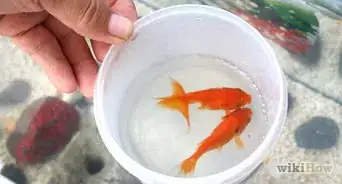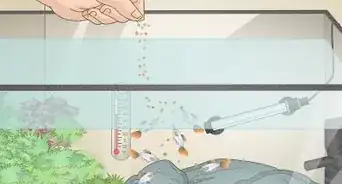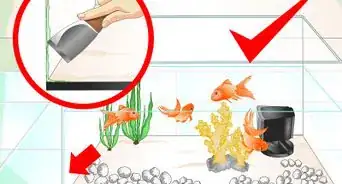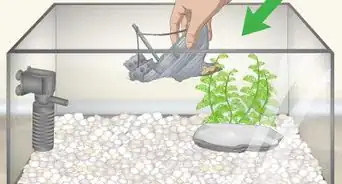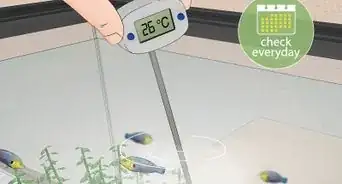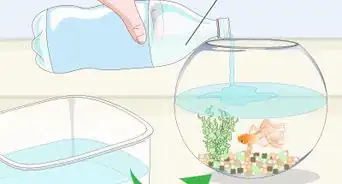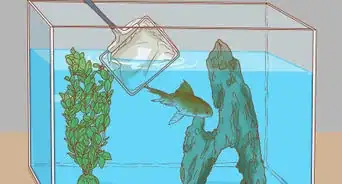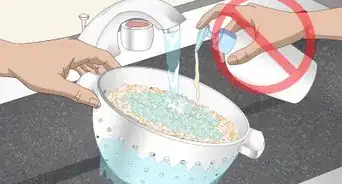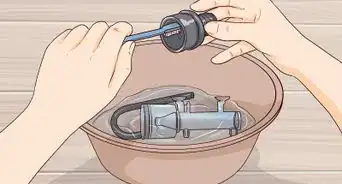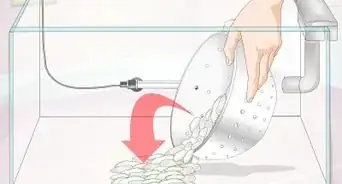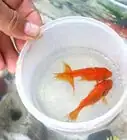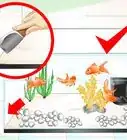This article was co-authored by Doug Ludemann. Doug Ludemann is the owner and operator of Fish Geeks, LLC, an aquarium services company based in Minneapolis, Minnesota. Doug has worked in the aquarium and fish-care industry for over 20 years, including having worked as a professional aquarist for the Minnesota Zoo and Shedd Aquarium in Chicago. He received his Bachelor of Science in Ecology, Evolution, and Behavior from the University of Minnesota.
This article has been viewed 42,881 times.
Every once in a while, you may need to take your fish out of their tank while you clean things up. To keep your fish safe while you’re cleaning, transfer them into a clean container partially filled with water from their aquarium. Removing fish from their habitat can be pretty stressful for them, so regularly change out the water, clean the gravel, and check the filters so that you don’t need to remove the fish very often. You can easily establish a good cleaning routine and take steps to keep your fish happy and healthy!
Steps
Relocating Fish While You Clean
-
1Leave the fish in their tank when you’re doing routine maintenance. If the tank is large enough that you can clean a section of it while your fish hang out at the other end, then you should be able to do most cleaning tasks without removing them. You can clean decorations by removing a few at a time, scrub sections of the tank’s walls, and even clean sections of gravel all without having to take your fish out.[1]
- Avoid removing your fish from their tank often. It can be shocking and stressful and can sometimes make them sick.
-
2Transfer the fish from their tank when you need to do a deep cleaning. This hopefully won’t happen very often, but when it does, it is essential to put your fish into a separate container as you clean their aquarium. You may also need to relocate your fish if their tank is too small for you to clean it without potentially injuring them.[2]
- If your tank is maintained regularly, you shouldn’t have to do extensive cleaning more than once every 6 months.
- Tanks that don’t have water pumps, filters, and other maintenance-equipment pieces do need to be cleaned by hand more often than larger aquariums.
Advertisement -
3Remove the aquarium decorations before you actually remove any fish. Wash your hands before reaching into the tank, and consider wearing clean rubber gloves to help protect your fish from any bacteria you might be carrying. Set the decorations to the side on a clean surface so you can clean them later.[3]
- Consider cleaning the decorations before removing the fish from the tank. That way, the fish will be out of their habitat for less time than if you were to wait to clean the decorations.
-
4Rinse out a container that is large enough to hold your fish. The container definitely doesn’t need to be as large as your tank, but it needs to be big enough that the fish will still have room to swim around a bit. Choose a container that is deep enough that your fish won’t be able to accidentally jump out of it. Rinse it with cool water to remove any dust or debris.[4]
- Never use soap or a chemical cleaner to prepare the container for your fish. Even if it’s rinsed off well, the remnants could still be harmful to your fish.
- If you have a small tank with just 1 or 2 fish, you could even use a large mug.
-
5Fill the container part way with water from the aquarium. Transfer water directly from the aquarium to the rinsed container, using a clean glass or measuring cup. Make the water deep enough that the fish can easily swim without scraping the bottom of the container.[5]
- This will help keep your fish from going into shock. It won’t have to worry about adjusting to a different temperature or pH balance because it’ll be in the same water.
- Both saltwater and freshwater fish are sensitive to the temperature and chemical levels in the water. Never put any fish directly into tap water.
-
6Scoop the fish out with a net and transfer them to the container. Be as gentle as possible, and try to transfer just 1 fish at a time. Once the fish is in the net, cover the top with your hand so they can’t wriggle out, and then submerge the net in the container and let the fish swim out on their own.[6]
- Never drop fish into the water from a height or try to flip them out of the net.
- Some fish are really fast swimmers and can be hard to catch, so be patient. Try to avoid pinning fish against the wall if you can. You may even want to use 2 nets to trap a fast-swimming fish.
Cleaning the Tank
-
1Clean the tank as quickly and as thoroughly as you can. Because the whole transferring process can be stressful to your fish, as can just being away from its normal habitat, try to work as quickly as you can to clean the tank. Plan out what you need to do beforehand and lay out the equipment you’ll need to use so everything is easily accessible.[7]
- Never leave your fish in the temporary container overnight. Make sure you set aside enough time to completely clean the tank all at once so that they’re back at home within a few hours at the most.
-
2Scrub the algae off the walls if it has become overgrown. Do this before removing any water. Sometimes the chemical balances in the water can make excessive algae grow and cover your tank, and it gets to be too much for your normal filtration system to handle. If this happens, use an algae scrubber to remove the visible sections of algae. You can also use your aquarium vacuum to siphon away any algae that is on the bottom of the tank.[8]
- If some sections are really stuck on, use a razor blade to scrape it off. Just be very careful to not accidentally hurt yourself.
EXPERT TIPDoug Ludemann is the owner and operator of Fish Geeks, LLC, an aquarium services company based in Minneapolis, Minnesota. Doug has worked in the aquarium and fish-care industry for over 20 years, including having worked as a professional aquarist for the Minnesota Zoo and Shedd Aquarium in Chicago. He received his Bachelor of Science in Ecology, Evolution, and Behavior from the University of Minnesota.Professional Aquarist
 Doug Ludemann
Doug Ludemann
Professional AquaristThe key to removing algae is exporting the nutrients that cause algae to grow. The cheapest way to do this is through water changes. You can also try protein skimming, which eliminates compounds from the water instead of only trapping them in a filter where they can break down and cause algae.
-
3Change 20% to 25% of the water if the tank is excessively dirty. Normal tank maintenance has you replace 10% to 15% of the water on a weekly basis, but sometimes you might need to do a little more. For example, if your tank hasn’t been cleaned in several weeks, or if your fish have started to get sick or die, you might need to do a larger change than you normally would. Keep in mind:[9]
- If you have a saltwater aquarium, you will need to check the saline, pH, and ammonia levels and get them back to a normal range before replacing your fish.
- If you have a freshwater aquarium, you will need to pay attention to the water temperature and dechlorinate the water before you add it to the tank.
-
4Transfer the fish back to the aquarium once you’re done cleaning. Once the tank is clean, gently net the fish and put them back into the aquarium. Remember to move 1 fish at a time and to lower the net into the aquarium to safely release them.[10]
- Don’t forget to feed your fish once they’re back home.
Maintaining Your Tank
-
1Change 10% to 15% of the tank’s water every week. Fill up a bucket (always use a clean bucket that has never been washed with chemicals or detergents) with tap water for a freshwater tank or reverse-osmosis water or distilled water for a saltwater tank. Check that the water temperature is the same as the water currently in the aquarium. For a freshwater tank, add in a de-chlorinator to treat the water. For a saltwater tank, treat the water with an aquarium-specific saline solution. Then use an automatic water changer to siphon off old water and replace it with the new water.[11]
- If you don’t have an automatic water changer, you’ll need to haul off several buckets-full of water manually and replace them with the fresh water.
- Don’t just “top off” the tank to replace water that has evaporated. The water still has some built-up impurities that need to be replaced, and that’s only done by removing and replacing water.
-
2Clean out the filters on a bi-weekly or monthly basis. Fill a small, clean bowl with water from the aquarium. Remove the filters and rinse them out in the bowl. Never use tap water, because that can remove the good bacteria that you need to keep your tank healthy. Replace the filters right away.[12]
- If the tubing for the filters looks dirty, use a pipe cleaner or filter brush to scrub them clean, too.
-
3Scrub away algae from the walls of the aquarium bi-weekly. Use an algae scrubber to scrape down the sides of the tank, working from the top of the tank down to the bottom. Make sure your hands are clean before you put them into the tank, or wear clean rubber gloves to do this work.[13]
- Never use a dish sponge or rag to clean the tank. These could introduce harmful bacteria to your aquarium.
- If you don’t already, think about getting some algae-eating creatures to help keep your tank clean.
-
4Siphon the gravel every 2 weeks to clean away waste. Use your aquarium vacuum by sticking one end into the gravel and following the manufacturer’s instructions. Vacuum the bottom of the tank back and forth until the water coming out the other end starts to run clear.[14]
- You usually don’t need to clean all of the gravel. Rather, try cleaning just 1/4 to 1/2 of it. This will leave some of the healthy bacteria in place that helps keep your aquarium’s habitat running.
-
5Remove and clean the tank decorations when they get visibly dirty. When you notice that the decorations in the tank are starting to get covered in algae, take a few minutes to remove the item and clean it off. Just clean 1 item at a time to keep from disrupting your fish.[15]
- Never use chemical cleaners or soap to clean aquarium decorations.
Community Q&A
-
QuestionWhat do I do when the fish gets caught in the net?
 Community AnswerPut the net back in the water and try to use your hands, without touching the fish, to set it free.
Community AnswerPut the net back in the water and try to use your hands, without touching the fish, to set it free. -
QuestionShould I use the same water while returning my fish back to the tank?
 Community AnswerNo, you should be using fresh water every time. Also make sure to have a water filter in the tank to regularly filter the water. With my fish, I have a few small snails in the tank to help clean the floor and walls.
Community AnswerNo, you should be using fresh water every time. Also make sure to have a water filter in the tank to regularly filter the water. With my fish, I have a few small snails in the tank to help clean the floor and walls. -
QuestionMy betta swims away when I try to remove him. What can I do?
 Community AnswerTry using food to get him to stop hiding, and use two nets to corner him.
Community AnswerTry using food to get him to stop hiding, and use two nets to corner him.
Warnings
- When dechlorinating water, do it over a period of 24 hours to make sure it is completely dechlorinated. Make sure to do this in a well ventilated area as well because the fumes released from this are toxic to both you and your fish.⧼thumbs_response⧽
- Avoid removing your fish every time you clean the tank. Doing so can stress them out and possibly make them sick.[16]⧼thumbs_response⧽
- Never use any chemical cleaners or detergents to clean your tank—these can kill your fish or make them very ill.[17]⧼thumbs_response⧽
Things You’ll Need
Relocating Fish While You Clean
- Rubber gloves
- Temporary container for fish
- Fish net
Cleaning the Tank
- Algae scrubber
- Razor blade
- Aquarium vacuum
- Fish net
Maintaining Your Tank
- Automatic water changer
- Small bowl
- Pipe cleaner or filter brush
- Algae scrubber
- Rubber gloves
- Aquarium vacuum
References
- ↑ http://www.firsttankguide.net/waterchange.php
- ↑ https://aquaristcourses.org/how-to-clean-your-fish-tank/
- ↑ http://www.firsttankguide.net/netting-fish.php
- ↑ http://www.firsttankguide.net/netting-fish.php
- ↑ http://www.firsttankguide.net/netting-fish.php
- ↑ http://www.firsttankguide.net/netting-fish.php
- ↑ https://aquaristcourses.org/how-to-clean-your-fish-tank/
- ↑ http://www.firsttankguide.net/waterchange.php
- ↑ http://web.mit.edu/lxs/www/cichlids/medication.html
- ↑ http://www.firsttankguide.net/netting-fish.php
- ↑ http://www.firsttankguide.net/waterchange.php
- ↑ http://www.firsttankguide.net/waterchange.php
- ↑ http://www.firsttankguide.net/waterchange.php
- ↑ http://www.firsttankguide.net/waterchange.php
- ↑ https://aquaristcourses.org/how-to-clean-your-fish-tank/
- ↑ https://aquaristcourses.org/how-to-clean-your-fish-tank/
- ↑ https://aquaristcourses.org/how-to-clean-your-fish-tank/
